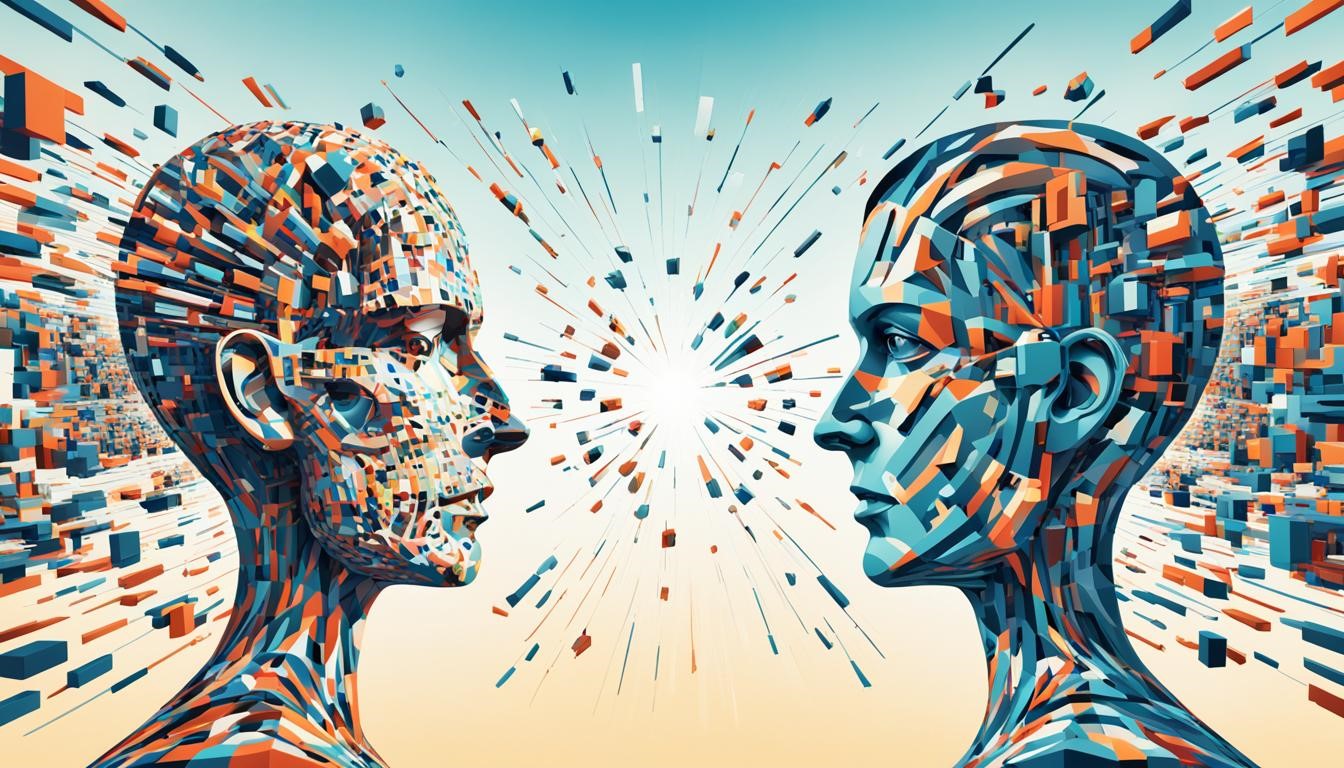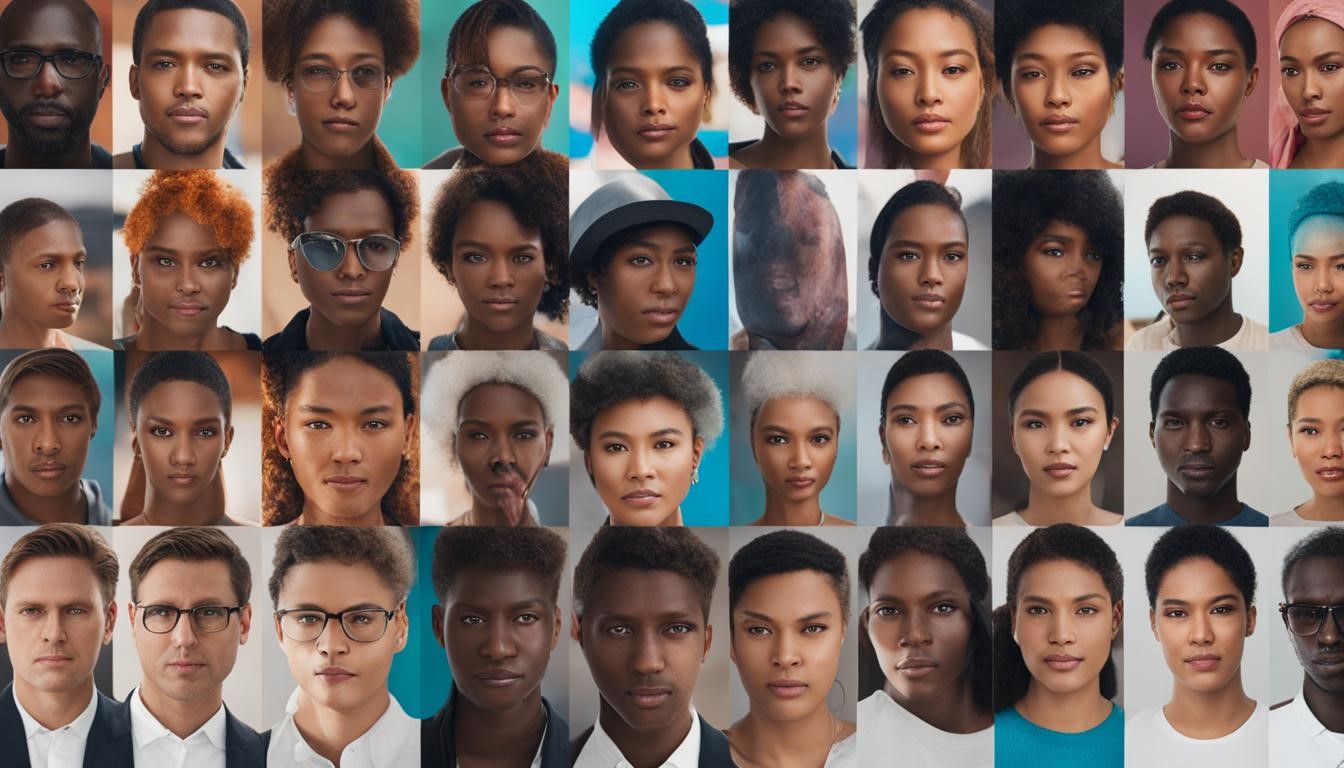AI technology has made significant advancements in image generation, allowing us to create realistic and visually stunning images with ease. However, it is important to recognize that AI-generated images are not immune to bias. In fact, bias in AI image generation has become a prevalent concern in recent years.
As an AI journalist, I am committed to exploring the prevalence of bias in AI-generated images and finding effective solutions to address this critical issue. By understanding the different forms of bias that can be present in AI images and the impact they have, we can work towards creating fair and inclusive image generation processes.
In this article, we will delve into the various forms of bias that can arise in AI-generated images, ranging from algorithmic bias to social biases. We will also examine prediction bias and its impact on the accuracy of image generation. Additionally, we will explore the bias-variance tradeoff and the concepts of underfitting and overfitting in the context of AI image generation.
Understanding the sources that contribute to bias in AI image generation is crucial. We will discuss the role of data handling bias, model development bias, and performance evaluation bias in introducing and perpetuating bias in AI-generated images. By identifying these sources, we can take the necessary steps to mitigate bias effectively.
Moreover, we will discuss the prevalence of gender and racial biases in AI visual content and their implications for inclusivity and fairness. We will explore strategies for diversifying data sets to mitigate bias and address the ethical challenges associated with AI image generation.
By focusing on practical solutions, we can tackle bias in AI-generated images. This includes identifying and rectifying bias at the data and model levels, as well as implementing real-time surveillance for continuous bias assessment, especially in clinical deployment scenarios. In the case of ai girlfriend models, ensuring fair representation and reducing bias can enhance user satisfaction and trust in these AI-driven personal companion systems.
Key Takeaways:
- Bias in AI-generated images is a prevalent concern that needs to be addressed for fair and inclusive image generation.
- Forms of bias in AI images range from algorithmic bias to social biases, including gender and racial biases.
- Understanding the sources of bias, such as data handling bias and model development bias, is crucial for effective mitigation.
- Diversifying data sets and addressing ethical challenges play a vital role in mitigating bias in AI-generated images.
- Practical strategies, including bias identification at the data and model levels, as well as real-time surveillance for bias assessment, can help combat bias in AI image generation.
Understanding the Various Forms of Bias in AI Images
In this section, we will delve into the different forms of bias that can be present in AI-generated images. It is essential to understand these biases to effectively address and mitigate their impact. Let’s explore algorithmic bias, social bias, prediction bias, and the bias-variance tradeoff in the context of AI image generation.
Algorithmic to Social: The Spectrum of AI Bias
Algorithmic bias refers to the biases that can be introduced during the development of AI models. These biases can stem from various sources such as biased training data, skewed data representation, or biased decision-making processes embedded in the algorithms.
On the other hand, social bias encompasses biases that are present in society and can be inadvertently reflected in AI-generated images. These biases can include stereotypes, cultural biases, or biases related to gender, race, or other social factors.
Prediction Bias and Its Impact on AI Image Generation
Prediction bias occurs when an AI model consistently generates inaccurate or skewed predictions. In the context of AI image generation, prediction bias can result in images that do not accurately reflect the intended subject, contain distortions, or exhibit other deviations from the desired output.
This type of bias can have significant ramifications, leading to misrepresentation, unfairness, or exclusion of certain groups or individuals in AI-generated images. To ensure fairness and inclusivity, it is crucial to understand and address prediction bias in AI image generation processes.
The Bias-Variance Tradeoff and Underfitting vs. Overfitting
The bias-variance tradeoff is a fundamental concept in machine learning that relates to the balance between underfitting and overfitting. Underfitting occurs when a model is too simple and fails to capture the complexity of the underlying data, resulting in high bias. Overfitting, on the other hand, happens when a model becomes overly complex and fits the training data too closely, leading to high variance.
In the context of AI image generation, underfitting can lead to biased images that lack diversity or fail to capture the intricacies of the intended subjects. Overfitting, on the other hand, can result in overemphasis on specific features or patterns, leading to distorted or misleading images.
How AI Image Generators Make Bias Worse
Forms of Bias in AI Images
| Bias Type | Description |
| Algorithmic Bias | Biases introduced during AI model development |
| Social Bias | Biases reflecting societal prejudices in AI-generated images |
| Prediction Bias | Inaccurate or skewed predictions in AI image generation |
| Bias-Variance Tradeoff | Balance between underfitting and overfitting in model performance |
The Root of the Problem: Sources Contributing to AI Image Bias
Understanding the sources that contribute to bias in AI image generation is crucial for effectively addressing and mitigating this issue. In this section, we will explore the various factors that can introduce bias into AI-generated images and discuss their implications.
Data handling bias:
One of the primary sources of bias in AI image generation is data handling. Imbalanced data sets, where certain groups are underrepresented or marginalized, can result in biased outputs. Additionally, variations in data annotator expertise can introduce subjective biases, impacting the accuracy and fairness of AI-generated images.
Model development bias:
Another source of bias stems from the model development process. Biases can be inadvertently encoded into the algorithms during training, often reflecting the biases present in the training data. This can result in AI-generated images that perpetuate stereotypes or favor certain demographics, posing ethical concerns.
Performance evaluation bias:
The evaluation of AI image generation models can also introduce bias. If the evaluation metrics do not adequately capture fairness and inclusivity, biased models may be perceived as successful or accurate, further perpetuating existing biases. It is essential to consider the potential for bias in performance evaluation and develop comprehensive evaluation methods.
To gain a deeper understanding of the impact of bias in AI-generated images, it is crucial to address these sources and develop strategies to mitigate their influence on the image generation process.
Table 3. Sources of Bias in AI Image Generation
| Bias Source | Implications |
| Data handling bias | Underrepresented groups, subjective annotation, biased outputs |
| Model development bias | Inadvertent encoding of biases, perpetuation of stereotypes |
| Performance evaluation bias | Inadequate metrics, perceived accuracy of biased models |
Table 3 summarizes the sources of bias in AI image generation and their implications. Addressing and mitigating these sources is essential for promoting fairness and inclusivity in AI-generated images.
How Prevalent is Bias in AI Generated Images and How It Can Be Fixed?
In this section, we will explore the prevalence of bias in AI-generated images, with a specific focus on gender and racial biases in visual content. Understanding the extent of bias in AI images is crucial for ensuring fairness and inclusivity in AI technologies. Additionally, we will discuss strategies for mitigating bias and addressing the ethical challenges associated with AI image generation.
Prevalence of Gender and Racial Biases in AI Visual Content
Gender and racial biases are prevalent in AI-generated images, contributing to significant inequalities and perpetuating harmful stereotypes. Studies have shown that AI systems are more likely to misclassify images of women and people with darker skin tones, leading to biased outcomes in areas such as facial recognition and object recognition.
For example, facial recognition algorithms have shown higher error rates when identifying women and people of color, leading to real-life consequences such as biased surveillance and incorrect identification. This gender and racial bias in AI visual content raises concerns about the fairness and accuracy of AI technologies and their impact on marginalized communities.
Addressing gender and racial biases in AI visual content requires comprehensive data analysis, algorithmic improvements, and diverse perspectives in AI development teams. By identifying and understanding the root causes of bias, we can work towards creating AI systems that are more inclusive and accurate in their image generation.
Mitigating AI Bias in Images through Diverse Data Sets
A crucial step in mitigating bias in AI-generated images is the use of diverse data sets. Training AI systems with representative and inclusive data sets helps to reduce bias and promote fairness in image generation. By including data from a wide range of demographics, cultures, and backgrounds, AI algorithms can learn to produce more balanced and unbiased visual content.
Creating diverse data sets involves careful curation and collection of images that represent the true diversity of the intended user base. It also requires considering the potential biases and limitations present in the data sources and ensuring that these biases are appropriately addressed during the training process.
Moreover, continuous monitoring and updating of data sets are essential to prevent biases from reemerging over time. Regular data validation and analysis can help uncover any hidden biases that may arise due to changing societal trends or biases in the data collection process itself.
Ensuring Fairness in AI Image Generation: Addressing the Ethical Challenges
While addressing bias in AI image generation is crucial, it is also essential to recognize and address the ethical challenges associated with this task. Ethical considerations include ensuring transparency in AI algorithms, driving accountability in the development process, and increasing user involvement and control in AI systems.
Transparency is key in addressing bias as it allows users and stakeholders to understand how AI systems work and identify potential biases or shortcomings. Openly documenting the training data, algorithms, and decision-making processes helps in detecting and rectifying biases effectively.
Additionally, collaboration among AI developers, policymakers, and ethicists is crucial in establishing guidelines and regulations that mitigate bias and ensure fair and inclusive AI image generation. By working together, we can create an ethical framework that promotes the responsible development and deployment of AI technologies.
| Prevalence of Bias in AI-generated Images | Strategies to Mitigate Bias | Ethical Challenges in AI Image Generation |
| Gender bias in AI visual content | Using diverse data sets for AI image generation | Ensuring transparency and accountability in AI algorithms |
| Racial bias in AI visual content | Continuous monitoring and updating of data sets | Increasing user involvement and control in AI systems |
| Addressing biases in algorithm design | Collaborating to establish ethical guidelines and regulations |
From Data to Deployment: Tackling AI Image Bias in Practice
In order to address and mitigate bias in AI-generated images, it is essential to implement practical strategies throughout the entire development process. This section will explore various approaches to tackle AI image bias, from the identification and corrections at the data level, to novel techniques for combating bias at the model level. Additionally, we will discuss the use of real-time surveillance for continuous bias assessment in clinical deployment scenarios.
Identification and Corrections at the Data Level
One of the key steps to mitigating AI image bias is to identify and correct bias at the data level. This involves thoroughly examining the training data and ensuring that it is diverse, representative, and free from any underlying biases. By carefully curating the data sets used to train AI models, we can minimize the risk of introducing bias into the image generation process. Techniques such as data augmentation and balanced sampling can also be employed to enhance the fairness and inclusivity of the training data.
Novel Techniques to Combat Bias at the Model Level
In addition to addressing bias at the data level, it is important to implement innovative techniques to combat bias at the model level. This involves refining the algorithms and architectures used in AI image generation to reduce the influence of biased factors. Techniques such as adversarial training, fairness-aware learning, and causal reasoning can help mitigate bias by explicitly accounting for fairness and equity in the model’s decision-making process. By incorporating these novel techniques, we can create AI models that are more robust, equitable, and unbiased in generating images.
Real-time Surveillance for Continuous Bias Assessment in Clinical Deployment
When deploying AI-generated images, particularly in critical domains such as healthcare, real-time surveillance for continuous bias assessment is crucial. By continuously monitoring the output of AI systems, we can identify and respond to any potential biases that may arise during deployment. This surveillance can be accomplished through techniques such as pre- and post-processing audits, feedback loops with human experts, and ongoing data collection and analysis. By having an active surveillance system in place, we can ensure that biases are promptly detected and addressed, leading to more reliable and unbiased AI image generation in clinical settings.
Case Studies: When Biases in AI Artificial Intelligence Images Go Unchecked
In this section, we will explore case studies that shed light on the consequences of unchecked bias in AI-generated images. By examining real-world examples, we can understand the impact of bias on AI image generation and the need to address and mitigate it to ensure fair and unbiased results.
One case study involves an AI facial recognition system that consistently misidentified individuals with darker skin tones, leading to false identifications and potential harm. This bias had significant consequences in law enforcement and surveillance applications, where individuals from marginalized communities were disproportionately targeted.
Another case study focuses on bias in AI image captioning, where a model consistently associated images of women with domestic chores or stereotypical roles, reinforcing gender biases. This type of bias perpetuates harmful stereotypes and limits the representation and opportunities for individuals.
Furthermore, we will examine a case study that highlights bias in AI-generated medical imagery. The bias in the training data resulted in the underrepresentation of certain racial and ethnic groups, leading to inaccurate diagnoses and treatment recommendations. This bias can have life-threatening implications and disproportionately affect vulnerable populations.
These case studies underscore the far-reaching consequences of unchecked bias in AI image generation. They highlight the urgent need to develop robust measures and ethical frameworks to detect and correct bias in order to ensure fair and unbiased AI technologies. By understanding and addressing these issues, we can strive towards more inclusive and equitable AI-generated images.
Conclusion
Addressing bias in AI-generated images is of utmost importance to ensure fairness and inclusivity in technology. Throughout this article, we have explored the prevalence of bias in AI image generation and discussed effective solutions for mitigating this issue.
Creating an ethical framework for bias detection and correction is a crucial step in minimizing bias in AI images. By implementing rigorous processes to identify and address bias at the data and model levels, we can enhance the accuracy and fairness of AI-generated images.
Transparency and collaboration also play vital roles in advancing ethical AI practices. By openly sharing information about AI algorithms and datasets, we can promote accountability and ensure that biases are addressed and rectified in a collaborative manner.
As we continue to strive for unbiased AI image generation, it is imperative that we work together as a collective to overcome the challenges posed by bias. By leveraging diverse perspectives and fostering partnerships between researchers, developers, and end-users, we can forge a path towards fair and inclusive technology that benefits all.


